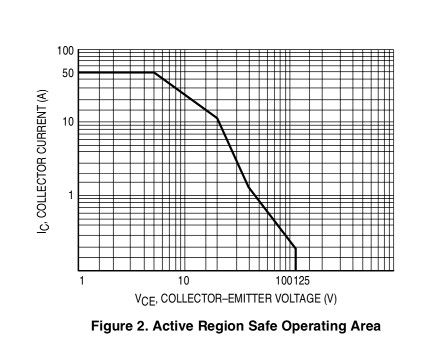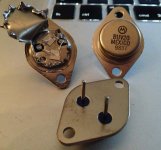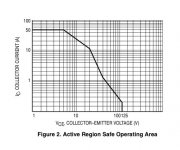hello,
a closing shop have old buv20 from ST or Moto. Not saw much amplifiers with this transistor. What would be wise, leave or buy ?
http://www.farnell.com/datasheets/685063.pdf
a closing shop have old buv20 from ST or Moto. Not saw much amplifiers with this transistor. What would be wise, leave or buy ?
http://www.farnell.com/datasheets/685063.pdf
Their SOA chart takes that into account. I suspect they're using resistance wire to do the bonding or something, as the kink in the SOA is there, but isn't all that dramatic:

$5 is a great price if they're real. Can you get some pictures?
Cheers,
Jeff.
$5 is a great price if they're real. Can you get some pictures?
Cheers,
Jeff.
Attachments
$5 piece. It's old stock from a well known shop.
Not too bad. I paid the same for MJ11032 and 33 darlingtons from Skycraft. Same 50 amps, and 30 volt SOA breakpoint. They actually share current reasonably well at high current and low voltage. If they didn’t you wouldn’t have any gain at 50 amps. The sharing breaks down at high voltages, hence the relatively poor SOA. All switching transistors, even single dies, do this. The reason the SOA falls off in the first place is because the current isnt uniformly distributed within even a single die. Same phenomenon, really.
I wouldn’t call them “useless” for audio - just not good for the typical application of running class AB 4 ohms on +/-50 to 70 volts. Where lower voltages are used and high currents are needed (no beta droop at 20 amps, for instance) , they could be better than spending two MJL3281. Lower package count, need fewer emitter resistors, and of course the metal case.
And I still have a couple of Je Ne Sais Quoi TO-3’s in the 50 amp package that are only labeled “K70” for type number. Anyone know if these are similar to the BUV20/21 or closer to the 2N5686? I’ve put a few of them into high current series regulators over the years, never anything more critical.
The dies aren't even mounted close together making the thermal coupling worse than it might be - the size of a hot-spot compared to the extent of the die(s) is key. Hot spots get smaller at higher power densities and with lower thermal conductivity, higher voltage allows hot-spots to reach higher ultimate power densities. You want the natural hot-spot size to be bigger than the die to keep roughly even dissipation across the die.
As a switching device the power density is at its greatest when the voltage is smallest, so hotspot development is much less severe.
As a switching device the power density is at its greatest when the voltage is smallest, so hotspot development is much less severe.
The SOA graph shows that in a typical +/- ~50V rail amplifier, that you only have about 1A@50V for reactive loads
This part is only useful at supply rails of about 30V
The Naim circuit is +/-40V, which gives you 4A on the SOA. That's about the same as the MJL3281 (4.5A). Those are at DC and 1Hz, so both will do better with a music signal.
I sure wish I knew what the BDY58 SOA curve looked like....
- Home
- Design & Build
- Parts
- BUV20 good or bad opportunity ?

